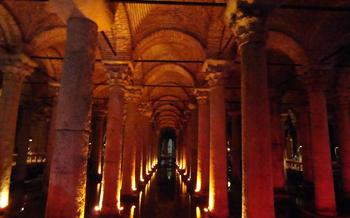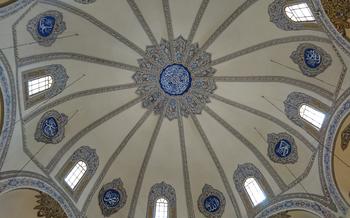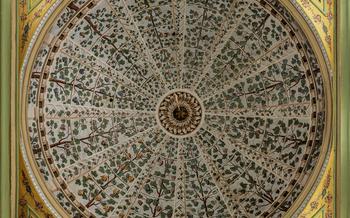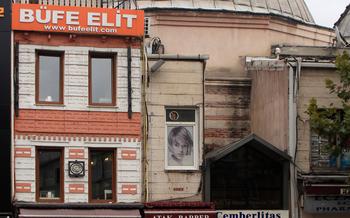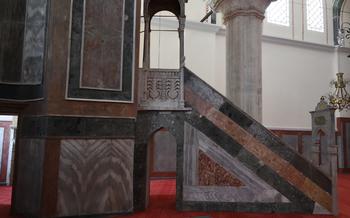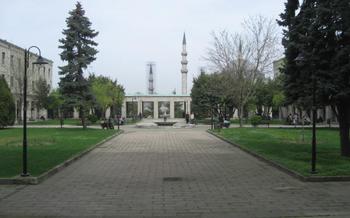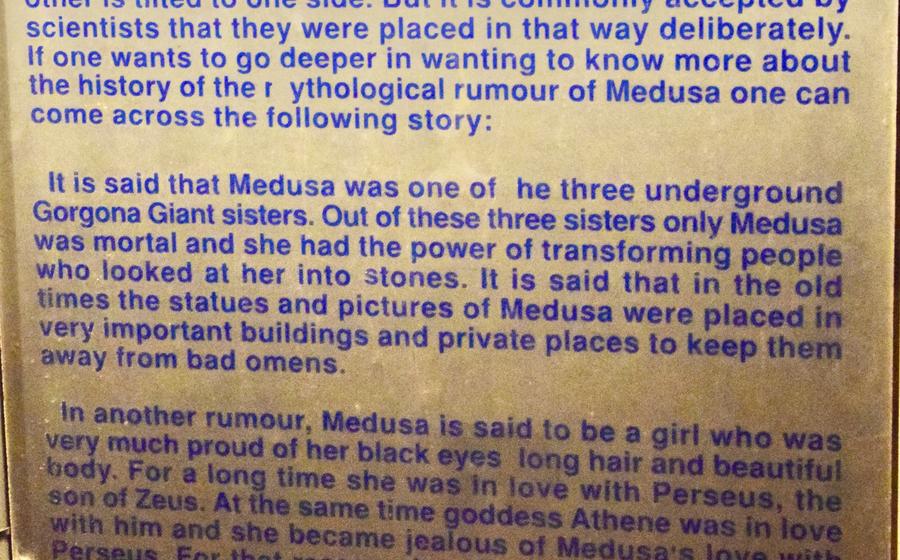
Basilica Cistern
- Unveiling the Basilica Cistern: An Underground Masterpiece
- A Journey Through Time: History of the Basilica Cistern
- Architectural Ingenuity: Marvels of the Basilica Cistern
- Location and Accessibility: Finding the Hidden Gem
- Practical Tips for a Smooth Visit
- Best Photo Spots: Capturing the Magic
- Insider Secrets: Unveiling Hidden Gems
- Other Must-See Cisterns in Istanbul
- A Glimpse into Byzantine Engineering
- Myths and Legends of the Basilica Cistern
- Conservation Efforts: Preserving a Timeless Treasure
- Virtual Tours and Online Resources
- Accessibility for Visitors with Disabilities
- Insider Tip: Off-the-Beaten-Path Experiences
Unveiling the Basilica Cistern: An Underground Masterpiece
Nestled beneath the bustling streets of Istanbul, the Basilica Cistern is a hidden gem that transports visitors back to the Byzantine era. This awe-inspiring underground chamber, built in the 6th century, served as a crucial water reservoir for the city's imperial palace. With its majestic columns, intricate mosaics, and mysterious Medusa heads, the Basilica Cistern stands as a testament to the engineering prowess and artistic brilliance of the Byzantine Empire. Located in the heart of the Sultanahmet district, this subterranean wonder offers a unique and immersive experience for travelers seeking to uncover the rich history and hidden treasures of Istanbul.
A Journey Through Time: History of the Basilica Cistern
The Basilica Cistern, a testament to Byzantine engineering prowess, boasts a rich and fascinating history. Constructed during the reign of Emperor Justinian I in the 6th century AD, it served as a crucial water reservoir for the Great Palace of Constantinople, the opulent residence of Byzantine emperors. The cistern's primary function was to store and distribute water from the nearby Belgrade Forest via a complex network of aqueducts. This ingenious system ensured a reliable water supply for the palace and its inhabitants, playing a vital role in sustaining the city's daily life. Over the centuries, the cistern underwent several modifications and repairs, reflecting the evolving needs and architectural styles of successive Byzantine rulers. In the 15th century, after the Ottoman conquest of Constantinople, the cistern fell into disuse and was gradually forgotten, buried beneath layers of earth and debris. It was not until the 19th century that the cistern was rediscovered and restored to its former glory, revealing the architectural wonders that had lain hidden for centuries. Today, the Basilica Cistern stands as a remarkable symbol of Byzantine ingenuity and a must-visit attraction for anyone seeking to delve into Istanbul's rich historical tapestry.
Architectural Ingenuity: Marvels of the Basilica Cistern
The Basilica Cistern stands as a testament to the architectural prowess of the Byzantine Empire. Its vast interior is supported by a forest of imposing columns and arches, creating a mesmerizing visual effect. The domed ceiling adds to the grandeur of the space, allowing natural light to filter through and illuminate the cistern's depths.
Visitors are drawn to the dazzling mosaics and sculptures that adorn the cistern's walls and niches. These intricate artworks depict scenes from mythology and religion, offering a glimpse into the artistic sensibilities of the Byzantine era. The most famous mosaic in the cistern is undoubtedly the Medusa heads, which have become iconic symbols of the Basilica Cistern. These enigmatic sculptures, with their piercing gazes and serpentine hair, have captured the imagination of visitors for centuries, adding an aura of mystery to the cistern's atmosphere.
The acoustics of the Basilica Cistern are another remarkable feature. The high vaulted ceilings and the reflective surfaces of the water create a unique acoustic environment. Sounds reverberate and echo throughout the cistern, creating an almost ethereal atmosphere. This phenomenon has made the Basilica Cistern a popular venue for concerts and performances, allowing visitors to experience the cistern's unique acoustics firsthand.
Location and Accessibility: Finding the Hidden Gem
The Basilica Cistern is conveniently located in the heart of Istanbul's historic Sultanahmet district, making it easily accessible to visitors. To find this hidden gem, head to the southwest corner of the Hagia Sophia and look for the unassuming entrance next to a small park. The cistern's exact address is Yerebatan Caddesi 1/3, Sultanahmet.
Reaching the Basilica Cistern is a breeze with Istanbul's efficient public transportation system. Take the T1 tram line and hop off at the Sultanahmet stop, just a short walk from the cistern. Alternatively, numerous buses stop nearby, including the 399, 44B, 46C, 91A, and 91B.
Once you've arrived, prepare to be amazed by the cistern's proximity to other iconic landmarks. The Hagia Sophia, Topkapi Palace, and Blue Mosque are all within walking distance, allowing you to combine your visit to the Basilica Cistern with a comprehensive exploration of Istanbul's historic treasures.
Practical Tips for a Smooth Visit
To ensure a smooth and enriching visit to the Basilica Cistern, here are some practical tips to keep in mind:
-
Ideal Time to Visit: Avoid the peak tourist season (June-August) and large tour groups to enjoy a more tranquil experience. Opt for early mornings or late afternoons to beat the crowds.
-
Ticket Prices and Availability: Check the official website or reputable ticket booking platforms for updated ticket prices and availability. Online booking is recommended to avoid queues.
-
Guided Tours: Enhance your visit with a guided tour led by knowledgeable experts. These tours provide insights into the cistern's history, architecture, and legends, making your experience more immersive.
-
Photography Guidelines: Photography is generally allowed within the cistern, but using a tripod or flash may not be permitted. Respect the guidelines and avoid disturbing other visitors.
Best Photo Spots: Capturing the Magic
The Basilica Cistern is a visual delight, offering endless opportunities for capturing stunning photographs. To make the most of your visit, here are some tips for capturing the cistern's magic through your lens:
-
Panoramic Shots: Start with capturing the cistern's grandeur with panoramic shots that showcase the vastness of the space. Use a wide-angle lens to capture the rows of columns, arches, and the ambient light filtering through the cistern's windows.
-
Architectural Details: Zoom in to capture the intricate details of the cistern's architecture. Focus on the ornate capitals atop the columns, the intricate carvings on the walls, and the mesmerizing patterns of the mosaic tiles.
-
Medusa Heads: Don't miss the chance to capture the iconic Medusa heads, a symbol of mystery and intrigue. Experiment with different angles and perspectives to create unique shots that showcase these enigmatic figures.
-
Creative Angles: Think beyond the obvious shots and experiment with creative angles to add depth and interest to your photographs. Try shooting from low angles to emphasize the height of the columns or from above to capture the patterns formed by the arches.
Insider Secrets: Unveiling Hidden Gems
Beyond the awe-inspiring interior of the Basilica Cistern, there's a world of hidden gems waiting to be discovered. For those seeking an off-the-beaten-path experience, here are some insider secrets:
-
Secret Passageways: The cistern is rumored to have secret passageways leading to other parts of the city. While most are inaccessible, some remain open, offering a glimpse into Istanbul's mysterious past.
-
Sultanahmet District: The cistern is located in the heart of the Sultanahmet district, a treasure trove of historical and cultural landmarks. Explore the nearby Hagia Sophia, Blue Mosque, and Topkapi Palace for a deeper dive into Istanbul's rich history.
-
Local Food Recommendations: Indulge in authentic Turkish cuisine at nearby restaurants. Try traditional dishes like kebabs, pide, and Turkish delight, and savor the flavors that make Istanbul a culinary paradise.
-
Hidden Gems in Istanbul: Istanbul is teeming with hidden gems beyond the cistern. Discover the vibrant Balat neighborhood, explore the colorful Grand Bazaar, or take a scenic ferry ride across the Bosphorus Strait.
Other Must-See Cisterns in Istanbul
While the Basilica Cistern is a must-see attraction, Istanbul boasts several other cisterns that offer unique experiences and historical insights.
-
Yerebatan Cistern: Located in the heart of Sultanahmet, the Yerebatan Cistern is another impressive underground marvel. Smaller than the Basilica Cistern, it features 336 columns adorned with intricate carvings and bas-reliefs. Visitors can enjoy a mesmerizing light show that illuminates the cistern's architectural details.
-
Binbirdirek Cistern: This hidden gem is located near the Grand Bazaar and is known for its unique atmosphere. With 224 columns arranged in 16 rows, the Binbirdirek Cistern has a more intimate feel. The name "Binbirdirek" means "a thousand and one columns" in Turkish, reflecting the cistern's vastness.
-
Suleymaniye Mosque Cistern: Discover the hidden reservoir beneath the Suleymaniye Mosque, one of Istanbul's most iconic landmarks. Constructed during the Ottoman period, this cistern served as a water supply for the mosque and its surrounding complex. Visitors can admire the cistern's impressive vaulted ceilings and well-preserved water channels.
A Glimpse into Byzantine Engineering
The Basilica Cistern showcases the remarkable engineering prowess of the Byzantine Empire. The cistern's innovative water management system, constructed over 1500 years ago, continues to impress engineers and architects to this day. Its sophisticated design ensured a reliable and efficient water supply for the city's growing population.
The cistern's construction materials and methods are a testament to Byzantine ingenuity. The massive columns, arches, and vaults were crafted from sturdy stone and brick, ensuring the cistern's durability and longevity. The use of waterproof mortar and plaster further enhanced the structure's watertightness.
Parallels can be drawn between the Basilica Cistern and other Byzantine structures, such as the Hagia Sophia and the Church of the Holy Apostles. The cistern shares architectural features and construction techniques with these iconic buildings, reflecting the Byzantine Empire's consistent approach to engineering and design.
The legacy of Byzantine engineering, exemplified by the Basilica Cistern, has had a profound impact on subsequent civilizations. Its innovative water management techniques and architectural principles have influenced later water infrastructure projects around the world. The cistern stands as a testament to the enduring legacy of Byzantine engineering, a legacy that continues to inspire and inform modern engineering practices.
Myths and Legends of the Basilica Cistern
The Basilica Cistern has captivated the imaginations of locals and visitors alike, giving rise to a rich tapestry of myths and legends. One of the most famous tales is the legend of the Medusa heads. According to legend, these imposing sculptures were once part of a pagan temple and were placed upside down to ward off evil spirits. Another legend speaks of hidden treasures and lost artifacts buried beneath the cistern's waters, waiting to be discovered by a lucky adventurer. Supernatural encounters and ghostly tales are also whispered among visitors, adding an air of mystery to the cistern's already enchanting atmosphere. The cistern holds a significant place in local culture, symbolizing the ingenuity and resilience of the Byzantine people.
Conservation Efforts: Preserving a Timeless Treasure
The Basilica Cistern, a testament to Byzantine engineering brilliance, faces several challenges in preserving its unique environment. The humid atmosphere, fluctuating temperatures, and constant water presence pose risks to the cistern's structural integrity and delicate mosaics. Ongoing restoration projects aim to address these issues, employing advanced techniques to stabilize the cistern's foundations, repair damaged mosaics, and protect the overall structure.
Balancing conservation with accessibility is a crucial aspect of preserving the cistern. While ensuring the site's safety and longevity, authorities strive to maintain its accessibility to visitors. Careful monitoring of visitor flow, implementation of sustainable tourism practices, and regular maintenance help strike a delicate balance between preservation and public enjoyment.
Future plans for the Basilica Cistern's preservation include further restoration projects to address any emerging issues, research into innovative conservation methods, and the development of educational programs to raise awareness about the cistern's historical significance and the importance of its preservation. These efforts aim to ensure that the Basilica Cistern remains a timeless treasure for generations to come.
Virtual Tours and Online Resources
Virtual tours offer an immersive way to explore the Basilica Cistern without even stepping foot inside. Interactive platforms like Google Arts & Culture provide 360-degree panoramas and virtual walkthroughs, allowing you to navigate the cistern's chambers and admire its architectural details up close.
Online exhibitions and historical information are also readily available, providing in-depth insights into the cistern's history, construction, and significance. Documentaries and videos offer a dynamic and engaging way to learn about the cistern's past and its place in Istanbul's rich tapestry.
Through these virtual resources, you can delve into the mysteries of the Basilica Cistern from the comfort of your home or as a valuable complement to your in-person visit. Online resources help make the cistern's wonders accessible to a global audience, promoting its historical and cultural significance beyond geographical boundaries.
Accessibility for Visitors with Disabilities
The Basilica Cistern is committed to providing an inclusive and accessible experience for all visitors, regardless of their physical abilities. Wheelchair users and visitors with limited mobility can easily navigate the cistern's interior thanks to ramps and designated accessible pathways. Trained staff is available to assist with any special needs or requests, ensuring a smooth and enjoyable visit for everyone. With its commitment to accessibility, the Basilica Cistern welcomes visitors from all backgrounds to explore its wonders and immerse themselves in its rich history.
Insider Tip: Off-the-Beaten-Path Experiences
While the Basilica Cistern is a must-see attraction, venturing off the beaten path can lead to equally rewarding experiences. Istanbul is home to several lesser-known cisterns, each with its own unique charm and historical significance. The Yerebatan Cistern, also known as the Sunken Cistern, is a smaller yet equally impressive underground marvel, while the Binbirdirek Cistern boasts a unique atmosphere with its 1,001 columns. The Suleymaniye Mosque Cistern, hidden beneath the grand mosque of the same name, offers a glimpse into a different era of Istanbul's history.
Beyond exploring these hidden cisterns, take the time to wander through the surrounding Sultanahmet district. This historic neighborhood is a treasure trove of architectural wonders, including the Hagia Sophia, the Blue Mosque, and the Topkapi Palace. Get lost in the labyrinthine streets, savor the delicious local cuisine, and soak in the vibrant atmosphere of this enchanting city.
For a truly unique experience, join a guided tour of the Basilica Cistern. These tours often provide in-depth insights into the history, architecture, and legends surrounding the cistern. Guides can also recommend other hidden gems in Istanbul, ensuring you make the most of your visit.
Finally, don't hesitate to seek recommendations from locals. They can point you towards lesser-known attractions, authentic Turkish restaurants, and off-the-beaten-path experiences that will give you a deeper understanding of Istanbul's rich culture and heritage. Embrace the spirit of exploration and let the city reveal its hidden treasures to you.
